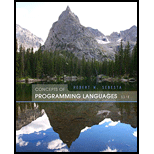
Concepts of Programming Languages (11th Edition)
11th Edition
ISBN: 9780133943023
Author: Robert W. Sebesta
Publisher: PEARSON
expand_more
expand_more
format_list_bulleted
Concept explainers
Textbook Question
Chapter 5, Problem 14RQ
What is the general problem with static scoping?
Expert Solution & Answer
Want to see the full answer?
Check out a sample textbook solution
Students have asked these similar questions
What is the overarching issue with static scoping?
Can subprograms be generic?
Can type checking be used while compiling a language with
dynamic scoping? Why? Is type checking feasible in a static
scoping language? Why?
Chapter 5 Solutions
Concepts of Programming Languages (11th Edition)
Ch. 5 - Prob. 1RQCh. 5 - Prob. 2RQCh. 5 - Prob. 3RQCh. 5 - Which category of C++ reference variables always...Ch. 5 - Prob. 5RQCh. 5 - Prob. 6RQCh. 5 - Prob. 7RQCh. 5 - Prob. 8RQCh. 5 - What are the advantages and disadvantages of...Ch. 5 - Prob. 10RQ
Ch. 5 - Prob. 11RQCh. 5 - Prob. 12RQCh. 5 - How is a reference to a nonlocal variable in a...Ch. 5 - What is the general problem with static scoping?Ch. 5 - What is the referencing environment of a...Ch. 5 - Prob. 16RQCh. 5 - What is a block?Ch. 5 - What is the purpose of the let constructs in...Ch. 5 - What is the difference between the names defined...Ch. 5 - Prob. 20RQCh. 5 - Prob. 21RQCh. 5 - What are the advantages of named constants?Ch. 5 - Which of the following identifier forms is most...Ch. 5 - Prob. 2PSCh. 5 - Write a simple assignment statement with one...Ch. 5 - Prob. 4PSCh. 5 - Describe a situation when a history-sensitive...Ch. 5 - Consider the following C program void fun (void) {...Ch. 5 - Consider the following skeletal C program: void...Ch. 5 - Which of the following identifier forms is most...Ch. 5 - Prob. 2PECh. 5 - Write a simple assignment statement with one...
Additional Engineering Textbook Solutions
Find more solutions based on key concepts
Explain what can be done with primary keys to eliminate key ripple effects as a database evolves.
Modern Database Management (12th Edition)
What is the output of the following (when embedded in a complete program)? int n = 5; while (--n 0) { if (n ==...
Problem Solving with C++ (9th Edition)
Private Sub Handles btnOutput.Click
End Sub
Introduction To Programming Using Visual Basic (11th Edition)
How many "hello lines does this program print?
Computer Systems: A Programmer's Perspective (3rd Edition)
(Tabular Output) Write a program that utilizes looping to produce the following table of values:
C How to Program (8th Edition)
Identity the termination condition in each of the following iterative statements. a. while (Count 5): . . . b....
Computer Science: An Overview (12th Edition)
Knowledge Booster
Learn more about
Need a deep-dive on the concept behind this application? Look no further. Learn more about this topic, computer-science and related others by exploring similar questions and additional content below.Similar questions
- Hi, asked a question earlier regarding the following problem! So sorry, I was able to understand the explanation of the expert, however the code was in C++ which I am still unfamiliar with. Wanted to ask how we can go about solving this problem in java? Question: You have probably heard about the deque (double-ended queue) data structure, which allows for efficient pushing and popping of elements from both the front and back of the queue. Depending on the implementation, it also allows for efficient random access to any index element of the queue as well. Now, we want you to bring this data structure up to the next level, the teque (triple-ended queue)! The teque supports the following four operations: push_back x: insert the element ?x into the back of the teque. push_front x: insert the element ?x into the front of the teque. push_middle x: insert the element ?x into the middle of the teque. The inserted element ?x now becomes the new middle element of the teque. If ?k is the…arrow_forwardIn java programming, is it better to use generics or collections for code reduction?arrow_forwardLearn about weak references in Java. How do they interact with garbage collection? How do they compare to weak_ptr objects in C++? Describe several scenarios in which they may be useful.arrow_forward
- Can a language that uses dynamic scoping do type checking at compile time? Why? Can a language that uses static scoping do type checking at run time? Why?arrow_forwardwhat is the difference between abstraction and polymorphism?arrow_forwardWhy method overloading is called compile-time polymorphism/static binding in java? explain with java codearrow_forward
- Is it possible to do type checking during the compilation of a language that uses dynamic scoping? Why? Is it feasible to do type checking in a language that uses static scoping? Why?arrow_forwardin c++ uses Templates, but Java uses Generic classes which one is better or you will choose which one why?arrow_forwardThe advantage of circular arrays for queues raises the question: Would the circularly-linked list benefit from the same considerations in C++ data structures? What's the point?arrow_forward
- What exactly is the distinction between abstraction and polymorphism?arrow_forwardin a few sentences say: c++ uses Templates, but Java uses Generic classes which one is better or you will choose which one why?arrow_forwardSOLVE IN C# How can sealed modifier be used to stop overriding.Give Examples.arrow_forward
arrow_back_ios
SEE MORE QUESTIONS
arrow_forward_ios
Recommended textbooks for you

What is Abstract Data Types(ADT) in Data Structures ? | with Example; Author: Simple Snippets;https://www.youtube.com/watch?v=n0e27Cpc88E;License: Standard YouTube License, CC-BY